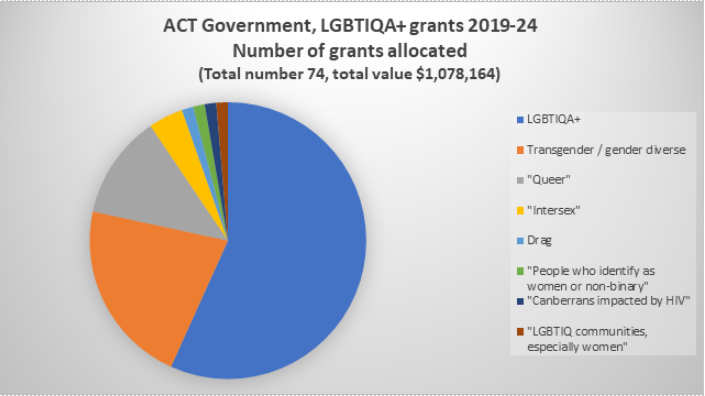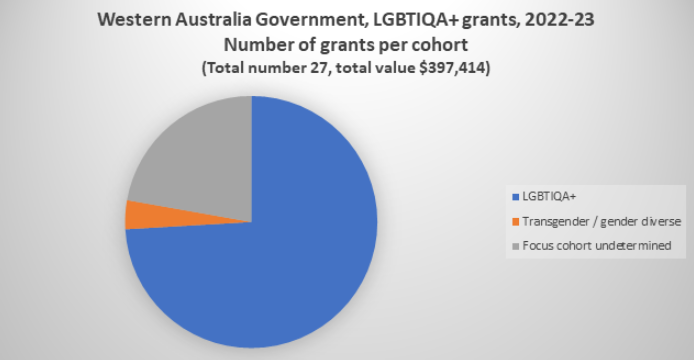Why won’t state governments fund LGB projects?
Lesbians, gay men and bisexuals have many differences. But there is one thing we all have in common: we are attracted to our own sex. This places us in a small minority and makes us vulnerable to isolation, discrimination, and related personal and social difficulties. It also brings positive experiences: of same sex relationships, friendships, resilience and creativity.
Because of all this, we benefit from having access to supports and events specific to LGB people sometimes, including in single sex environments.
Last year, LGB Alliance Australia surveyed our supporters and found that more than two-thirds thought our top priority should be campaigning for single sex LGB spaces or events. 8 out of 10 said there were no such spaces or events where they lived. Half said this absence had negatively affected their wellbeing and a quarter said it had made it hard for them to find a partner.
However, you would not know that such concerns existed if you looked at the “rainbow” community events funded by Australia’s state and territory governments.
Community projects funded by state governments are usually aimed at the ever-expanding cohort of “LGBTIQA+”, with a minority of projects funded specifically for “queer”, “transgender / gender diverse” and “intersex” cohorts.
Funding for single sex spaces or projects focused specifically on LGB people is nowhere to be seen.
We have written elsewhere about this issue in Victoria. Here, we examine grants allocated by other state and territory governments for projects to strengthen “rainbow” communities.
For consistency, we looked only at grants awarded directly by state and territory governments for individual “rainbow” community projects. (Corporate and philanthropic grants, which are big in some states like NSW, will be looked at separately.) Doubtless we did not capture every relevant grant allocated, but a picture emerges from looking at the following rounds:
Australian Capital Territory: Capital of Equality Connection Fund projects, Partnerships and Capacity Building projects, and original grants rounds
New South Wales: Seniors Festival Grants, Youth Opportunities Grants, CLIRP Arts and Culture Priority Needs Program
South Australia: Department of Human Services, Grants SA
Tasmania: LGBTIQA+ Grants Program
Western Australia: Mental Health Commission LGBTIQ+ Community Grants and LGBTQIA+ Youth Empowerment Grants Program
A detailed breakdown is available on request. In summary, here’s what we found:
As far as we could tell, none of these state or territory governments allocated any grants in recent years to community initiatives specifically for lesbian, gay and/or bisexual individuals.
Several grants went to community projects which, in practice, may have worked predominantly with same sex attracted individuals: projects for “Canberrans impacted by HIV”, “LGBTIQ communities, especially women”, “queer women”, and “people who identify as women or non-binary”.
However, none of these initiatives made any clear, firm undertaking to focus on lesbians, gay men and/or bisexuals. These groups were not even named up front.
Doubtless many LGB people take part in “LGBTIQA+” projects and enjoy the experience. However, there is no promise of a single sex environment or a focus on same sex attraction, despite the fact that many LGB people would like those things at least sometimes.
Why do Australian state and territory governments almost never allocate grant money to community initiatives just for lesbian, gay or bisexual individuals? Does this reflect the priorities of state funding bodies or the community organisations that pitch for funding – or both?
Perhaps the preference for “LGBTIQA+” initiatives reflects little more than institutions’ embrace of contemporary trends. Perhaps it is assumed that making initiatives open to as many people as possible delivers greater benefits.
However, if this approach were taken to its logical conclusion, there would be no more grants for any particular cohorts at all – e.g. senior citizens, disability groups. As it is, we might speculate that some “LGBTIQA+” initiatives could, in theory, engage no LGB people at all and still claim reasonably to have done their job, as long as they engaged individuals who were “TQIA+”.
Moreover, the willingness of most state and territory governments to fund community projects for other specific cohorts – e.g. “intersex” projects – shows there is no essential opposition to supporting initiatives meant for certain groups only.
Just not for lesbians, gay men or bisexuals.
Whatever sits behind this approach, we do not support it. It is not unreasonable for LGB people to want to experience single sex spaces and a focus on same sex attraction some of the time.
The Queensland Government recently dedicated $200,000 to a grants round to support “grassroots LGBTIQA+ organisations” – the first initiative of its kind in that state.
When the funding is announced, we hope it will reflect the full range of LGB people’s wishes and needs, rather than repeating the unsatisfactory patterns of other states.





